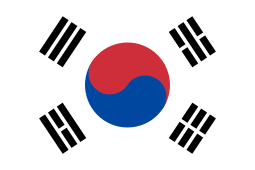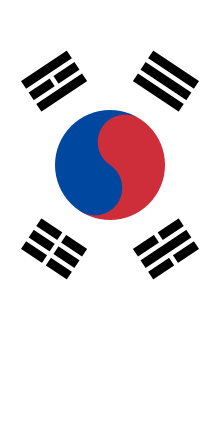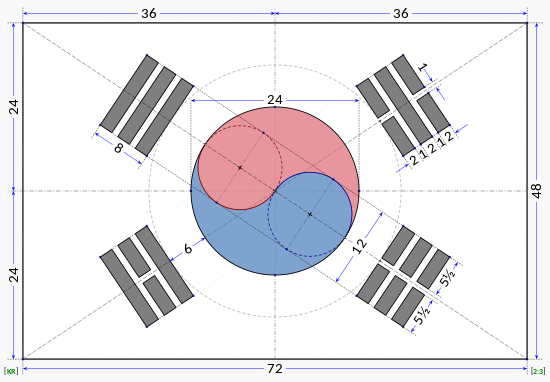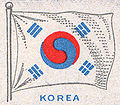Flag of South Korea
 | |
| Taegeukgi/Taegukgi (Korean:태극기,Hanja:TháiCựcKỳ) | |
| Use | National flagandensign |
|---|---|
| Proportion | 2:3 |
| Adopted | January 27, 1883(original version, used by the Joseon dynasty) June 29, 1942(during Japanese occupation, by the exiledProvisional Government of the Republic of Korea) October 15, 1949(for South Korea, by thefirst Republic of Korea,current geometry) May 30, 2011(current colors) |
| Design | A white field with a centered red and bluetaegeuksurrounded by fourtrigrams |
| Designed by | Lee Eung-jun andMa Jianzhong(Designed) Park Yung-hyo(Selected) Gojong(Approved) |
| Naval jack | |
 | |
| Use | Naval jack |
| Proportion | 2:3 |
| Design | A blue field with a white canton that has a red and bluetaegeuksuperimposed on two crossed anchors. |
| Governmental ensign | |
 | |
| Use | Government ensign |
| Proportion | 2:3 |
| Design | A white field with the logo of thegovernmentin the middle |
| Flag of South Korea | |
| Hangul | 태극기 |
|---|---|
| Hanja | |
| Revised Romanization | Taegeukgi |
| McCune–Reischauer | T'aegŭkki |
The national flag of theRepublic of Korea,also known as theTaegeukgi(also romanized asTaegukgi,Korean:태극기;lit.taegeukflag), has three parts: a white rectangular background, a red and bluetaegeukin its center, accompanied by four blacktrigrams,one in each corner. Flags similar to the currentTaegeukgiwere used as the national flag of Korea by theJoseondynasty, theKorean Empire,as well as theKorean government-in-exile during Japanese rule.South Koreaadopted theTaegeukgifor its national flag when it gained independence from Japan on 15 August 1945.
History[edit]
In 1876, the absence of anational flagbecame an issue for Korea, at the time reigned over by theJoseondynasty. Before 1876, Korea did not have a national flag, but the king had his own royal standard. The lack of a national flag became a quandary during negotiations for theJapan–Korea Treaty of 1876,at which the delegate ofJapandisplayed theJapanese national flag,whereas the Joseon dynasty had no corresponding national symbol to exhibit. At that time, some proposed to create a national flag, but the Joseon government looked upon the matter as unimportant and unnecessary. By 1880, the proliferation of foreign negotiations led to the need for a national flag.[1]The most popular proposal was described in the "Korea Strategy" papers, written by the Chinese delegateHuang Zunxian.It proffered to incorporate theflag of the Qing dynastyof China into that of the Joseon dynasty of Korea. In response to the Chinese proposal, the Joseon government dispatched delegate Lee Young-Sook to consider the scheme with Chinese statesman and diplomatLi Hongzhang.Li agreed with some elements of Huang's suggestion while accepting that Korea would make some alterations. TheQinggovernment assented to Li's conclusions, but the degree of enthusiasm with which the Joseon government explored this proposal is unknown.[2]
The issue remained unpursued for a period but reemerged with the negotiation of theUnited States–Korea Treaty of 1882,also known as the Shufeldt Treaty. The U.S. emissaryRobert Wilson Shufeldtsuggested that Korea adopt a national flag to represent its sovereignty. The king of Joseon,Kojong,ordered government officialsSin HeonandKim Hong-jipto begin working on a new flag. Kim Hong-jip in turn asked delegateLee Eung-junto create the first design, which Lee Eung-jun presented to the Chinese officialMa Jianzhong.Ma Jianzhong argued against Huang Zunxian's proposal that Korea adopt the flag of the Qing dynasty, and proposed a modified dragon flag.[2]Kojong rejected this idea.[3]Ma suggested Lee Eung-jun'sTaegeukandEight Trigramsflag.[4]Kim and Ma proposed changes to it: Kim proposed changing the red to blue and white; Ma proposed a white field, a red and blacktaegeuk,trigrams in black, and a red border.[2]On 14 May 1882, before theJoseon–United States Treaty of 1882,Park Yeong-hyo presented ascale modelof the Lee Eung-jun'staegukgito the Joseon government, and Gojong approved the design. Park Yeong-hyo became the first person to use thetaegukgiin 1882.[5]The 2 October 1882 issue of the Japanese newspaperJiji shimpōcredited Gojong as the designer of thetaegukgi(i.e., a flag with a red and bluetaegeukand four trigrams).[6]On 27 January 1883, the Joseon government officially promulgated thetaegukgito be used as the official national flag.[2]
In 1919, a flag similar to the current South Korean flag was used by theKorean government-in-exilebased inChina.The termtaegukgibegan to use in 1942. Thetaegukandtaegukgigrew as a powerful symbols of independence in the 1,500 demonstrations during colonial rule.

Following therestoration of Korean independencein 1945,taegukgidesigns was no longer punishable, it remained in use as the southern portion of Korea became a republic under the influence of theUnited Statesand even in thePeople's Republic of Koreafor a time. TheUnited States Army Military Government in Koreastarted to usetaegukgialongside theflag of the United Stateson 14 January 1946. On 12 July 1948, theConstituent National Assembly of the Republic of Koreaadoptedtaegukgias national flag.[7]Following the establishment of the South Korean state in August 1948, thefirst Republic of Koreacreated the National Flag Correction Committee in January 1949 to establish the modern standardization fortaegukgi.On 15 October 1949, the Ministry of Education and Culture announcedNational Flag Production Law.[2][8][9]
Northern portion of Korea have also usedtaegukgiuntil thenew designwas introduced in July 1948.
In February 1984, exact dimensional specifications for the flag were codified.[10][11][12][13]In October 1997, a precise color scheme for the flag was fixed via presidential decree for the first time.[8][14]
Symbolism[edit]
The flag's field is white, a traditional color inKorean culturethat was common in the daily attire of 19th-century Koreans and still appears in contemporary versions of traditional Korean garments such as thehanbok.The color represents peace and purity.[8]
The circle in the flag's center symbolizes balance in the world. Derived from the ChineseI ChingandTaiji (philosophy),known in the west as the Yin and Yang, the blue half representsnegative energy (Yin),and the red half represents thepositive energy (Yang).
Together, thetrigramsrepresent movement and harmony as fundamental principles. Each trigram (Korean:괘;Hanja:Quái;RR:gwae) represents one of the fourclassical elements,[15]as described below:
| Trigram | Koreanname | Celestial body | Season | Cardinal direction | Virtue | Family | Natural element | Meaning | Social fabric |
|---|---|---|---|---|---|---|---|---|---|
| geon (건;Càn) |
heaven (천;Thiên) |
summer (하;Hạ) |
south (남;Nam) |
wisdom (인;Nhân) |
father (부;Phụ) |
air (천;Thiên) |
justice (정의;Chính nghĩa) |
The strong stay together. | |
| gon (곤;Khôn) |
earth (지;Địa) |
winter (동;Đông) |
north (북;Bắc) |
righteousness (의;Nghĩa) |
mother (모;Mẫu) |
earth (토;Thổ) |
vitality (생명력;Sinh mệnh lực) |
The weak stay together. | |
| ri (리;Ly) |
sun (일;Nhật) |
spring (춘;Xuân) |
east (동;Đông) |
courtesy (례;Lễ) |
daughter (녀;Nữ) |
fire (화;Hỏa) |
fruition (결실;Kết thật) |
The strong protect the weak. | |
| gam (감;Khảm) |
moon (월;Nguyệt) |
autumn (추;Thu) |
west (서;Tây) |
intelligence (지;Trí) |
son (자;Tử) |
water (수;Thủy) |
wisdom (지혜;Trí tuệ) |
The weak protect the strong. |
Cultural role in contemporary South Korean society[edit]
The name of the South Korean flag is used in the title of a 2004 film about theKorean War,Taegukgi.[16]
Observers such asThe Times Literary Supplement's Colin Marshall and Korea scholarBrian Reynolds Myershave noted that the South Korean flag in the context of the country's society is often used as anethnic flag,representing a grander nationalistic idea of aracialized (Korean) peoplerather than merely symbolizing the (South Korean) state itself as national flags do in other countries.[17][18]Myers argues that: "When the average [South Korean] man sees the [South Korean] flag, he feels fraternity with [ethnic] Koreans around the world."[19]Myers also stated in a 2011 thesis that: "Judging from the yin-yang flag's universal popularity in South Korea, even among those who deny the legitimacy of the Republic of Korea, it evidently evokes the [Korean] race first and the [South Korean] state second."[20]
Desecration[edit]
The South Korean flag is considered by a large part of the country's citizens to represent the "Korean race" rather than solely the South Korean state; consequentlyflag desecrationby the country's citizens is rare when compared to other countries, where citizens may desecrate their own national flags as political statements. Thus those South Korean citizens opposed to the state's actions or even its existence will still treat their national flag with reverence and respect: "There is therefore none of the parodying or deliberate desecration of the state flag that one encounters in the countercultures of other countries."[20]
Regardless of frequency, the South KoreanCriminal Actpunishes desecration of the South Korean national flag in various ways:[21]
- Article 105 imposes up to 5 years in prison,disfranchisementof up to 10 years, or a fine up to 7 millionSouth Korean wonfor damaging, removing, or staining a South Korean flag oremblemwith intent to insult the South Korean state. Article 5 makes this crime punishable, even if done by aliens outside South Korea.[21]
- Article 106 imposes up to 1 year in prison, disfranchisement of up to 5 years, or a fine up to 2 million South Korean won fordefaminga South Korean flag or emblem with intent to insult the South Korean state. Article 5 makes this crime punishable, even if done by aliens outside South Korea.[21]
South Korea also criminalizes not just desecration of the South Korean flag, but the flags of other countries as well:
- Article 109 imposes up to 2 years in prison or a fine up to 3 million South Korean won for damaging, removing, or staining a foreign flag or emblem with intent to insult a foreign country. Article 110 forbidsprosecutionwithout foreign governmental complaint.[21]
Specifications[edit]


Dimensions[edit]

The width and height are in the ratio of 3:2. There are five sections on the flag, thetaegeukand the four groups of bars (trigrams). The diameter of thetaegeukis half of the height of the flag. The top of thetaegeukis red and the bottom of thetaegeukis blue. The design of thetaegeuk,as well as the trigrams residing in each of the four corners, are geometrically defined.[22]
Colors[edit]

The colors of thetaegukgiare specified in the "Ordinance Act of the Law concerning the National Flag of the Republic of Korea" (Korean:대한민국 국기법 시행령).[24]The color scheme was unspecified until 1997, when theSouth Korean governmentdecided to standardize specifications for the flag. On 25 October 1997, aPresidentialordinance on the standard specification of the South Korean flag was promulgated,[25][26]and that specification was acceded by theNational Flag Lawin July 2007.
Colors are defined in legislation by theMunsellandCIEcolor systems as follows:
| Scheme | Munsell[27] | CIE (x, y, Y)[27] | Pantone[23] | Hex triplet(converted from CIE) |
|---|---|---|---|---|
| White | N 9.5 | — | — | #FFFFFF |
| Red | 6.0R 4.5/14 | 0.5640, 0.3194, 15.3 | 186 C | #CD2E3A |
| Blue | 5.0PB 3.0/12 | 0.1556, 0.1354, 6.5 | 294 C | #0047A0 |
| Black | N 0.5 | — | — | #000000 |
Gallery[edit]
-
 Joseon dynastynaval ensign
Joseon dynastynaval ensign -
 TaegukgibyPark Yeong-hyo(September 1882)
TaegukgibyPark Yeong-hyo(September 1882) -
 Taegukgiin a Qing diplomatic bookTōngshāng Zhāngchéng Chéng'àn Huìbiān( thông thương chương trình thành án hối biên ), edited byLi Hongzhang(March 1883). Annotated "The flag ofGoryeobelonging to theGreat Qing".Joseon was sometimes called 'Goryeo' in China.
Taegukgiin a Qing diplomatic bookTōngshāng Zhāngchéng Chéng'àn Huìbiān( thông thương chương trình thành án hối biên ), edited byLi Hongzhang(March 1883). Annotated "The flag ofGoryeobelonging to theGreat Qing".Joseon was sometimes called 'Goryeo' in China. -
 Flag of theKorean Empire(1897–1910)
Flag of theKorean Empire(1897–1910) -
 Imperial standard of theKorean Empire(1897–1910)
Imperial standard of theKorean Empire(1897–1910) -
 A flag made byAn Jung-geun,a Korean independence activist who died in 1910. "Đại hàn độc lập (The independence of Greater Korea) "is written.
A flag made byAn Jung-geun,a Korean independence activist who died in 1910. "Đại hàn độc lập (The independence of Greater Korea) "is written. -
 Flag of Korean protestors used in 1919 during theMarch 1st Movement
Flag of Korean protestors used in 1919 during theMarch 1st Movement -
Taegukgiwith signatures byKorean Liberation Army(1945)
-
 A flag of thePeople's Republic of Koreafrom August 1945 until December 1945, when theUSAMGIKoutlawed the PRK
A flag of thePeople's Republic of Koreafrom August 1945 until December 1945, when theUSAMGIKoutlawed the PRK -
 Theflag of the United Statesused during theU.S. military occupation of the southern part of Koreafrom 1945–1948
Theflag of the United Statesused during theU.S. military occupation of the southern part of Koreafrom 1945–1948 -
 Taegukgiused by theUnited States Army Military Government in Koreafrom 1945 to 1948
Taegukgiused by theUnited States Army Military Government in Koreafrom 1945 to 1948 -
2011–present
-
Taegukgiwith anti-North Korean slogans and signatures bystudent soldiersfromGyeongju(1950)
-
Flag of theRepublic of Korea Army
-
Flag of theRepublic of Korea Air Force
-
Flag of theRepublic of Korea Marine Corps
-
A large display of theSouth Koreanflag during an association football match againstHaiti
-
A series ofSouth Koreanflags flying on a street
See also[edit]
- List of Korean flags
- List of South Korean flags
- Korean Unification Flag
- Pledge of allegiance to the flag of South Korea
References[edit]
- ^"대한민국[Republic of Korea, đại hàn dân quốc ]"(in Korean). Doosan Corporation.Retrieved5 November2013.
- ^abcde태극기[Taegukgi] (in Korean).Academy of Korean Studies.Retrieved5 November2013.
- ^"대한민국의 국기".terms.naver.com(in Korean).Retrieved20 December2020.
- ^Wang, Yuanchong (15 December 2018).Remaking the Chinese Empire: Manchu-Korean Relations, 1616–1911.Cornell University Press.p. 154.ISBN978-1-5017-3051-1.
For Chosŏn's national flag, Ma suggested Yi Ŭngjun's design of the Taiji and eight trigrams as the basic model.
- ^""태극기는 천손민족의 표시..중국보다 앞서"".OhmyNews(in Korean). 20 April 2007.Retrieved20 December2020.
- ^이상희 (2004). "태극기" [Taegeukgi].꽃으로 보는 한국문화[Korean Culture as Flowers]. 넥서스BOOKS. pp. 75–97.
- ^abc"National Administration: National Symbols of the Republic of Korea: The National Flag – Taegeukgi".Ministry of the Interior and Safety.Retrieved9 January2018.
- ^관보[Official Gazette]. Government of the Republic of Korea. 15 October 1949.Retrieved18 January2022.
- ^"History of the South Korean flag".fotw.fivestarflags.com.
- ^"flag of Korea, South".Encyclopedia Britannica. 20 December 2023.
- ^"History of the South Korean flag".Christusrex.org.Archived fromthe originalon 26 March 2017.Retrieved9 January2018.
- ^"Flag History".Destination South Korea.Retrieved9 January2018.
- ^"NATIONAL SYMBOLS OF THE REPUBLIC OF KOREA".Ministry of the Interior and Safety.Retrieved9 January2018.
- ^"The World Factbook".Central Intelligence Agency.Retrieved4 November2013.
- ^Elley, Derek (18 June 2004)."Taegukgi".Variety.Retrieved21 January2024.
- ^Archived atGhostarchiveand theWayback Machine:O'Carroll, Chad (2014)."BR Myers – Current Issues".YouTube.Retrieved11 September2017.
[T]he South Korean flag continues to function, at least in South Korea, not as a symbol of the state but as a symbol of the race.
- ^Marshall, Colin (2017)."How Korea got cool: The continued rise of a country named Hanguk".The Times Literary Supplement.Retrieved24 June2019.
When people wave the South Korean flag, in other words, they wave the flag not of a country but of an [ethnic] people.
- ^"North Korea's Unification Drive— B.R. Myers".Sthele Press.20 December 2017.Retrieved9 January2018.
- ^abMyers, Brian Reynolds(2011)."North Korea's state-loyalty advantage".Free Online Library.Archived fromthe originalon 20 May 2018.Retrieved29 May2018.
- ^abcd"Criminal Act".South Korean Laws.14 May 2014.Retrieved3 January2017.
- ^"국가상징 > 태극기 > 태극기 더보기 > 국기의 제작".Theme.archives.go.kr.Retrieved9 January2018.
- ^ab"National Flag".infokorea.ru.The Embassy of the Republic of Korea in Moscow. Archived from the original on 18 January 2012.Retrieved6 August2017.
{{cite web}}:CS1 maint: bot: original URL status unknown (link) - ^대한민국국기법 시행령[The law concerning practice for the flag of the Republic of Korea] (in Korean). Government of the Republic of Korea.Retrieved6 August2017.
- ^관보[Official Gazette] (in Korean). Government of the Republic of Korea. 25 October 1997.Retrieved5 June2024.
- ^ab국기의 제작[Geometry of the National Flag] (in Korean). Ministry of the Interior and Safety. 2017.Retrieved6 August2017.
- ^abhttp://internationalcongressesofvexillology-proceedingsandreports.yolasite.com/resources/23rd/Kariyasu-TheHistoryofTaegeukFlags.pdf[bare URL PDF]
External links[edit]
 Media related toNational flag of South Koreaat Wikimedia Commons
Media related toNational flag of South Koreaat Wikimedia Commons Quotations related toFlag of South Koreaat Wikiquote
Quotations related toFlag of South Koreaat Wikiquote KoreanWikisourcehas original text related to this article:대한민국 대한민국국기법
KoreanWikisourcehas original text related to this article:대한민국 대한민국국기법- South KoreaatFlags of the World


![Joseon dynasty royal standard (1882–1907)[28]](https://upload.wikimedia.org/wikipedia/commons/thumb/e/e5/Flag_of_the_king_of_Joseon.svg/120px-Flag_of_the_king_of_Joseon.svg.png)
![Joseon dynasty royal standard (reverse, 1882–1907)[28]](https://upload.wikimedia.org/wikipedia/commons/thumb/e/e1/%E6%9C%9D%E9%AE%AE%E5%9C%8B%E7%8E%8B%E7%8E%8B%E6%97%97.PNG/120px-%E6%9C%9D%E9%AE%AE%E5%9C%8B%E7%8E%8B%E7%8E%8B%E6%97%97.PNG)




























